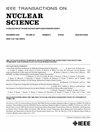Investigation on the Gamma-Rays Induced Radiation Damage Effect of LaBr₃:Ce and CeBr₃ Crystals
IF 1.9
3区 工程技术
Q3 ENGINEERING, ELECTRICAL & ELECTRONIC
引用次数: 0
Abstract
This work investigates gamma-rays induced radiation damage effect in LaBr3:Ce and CeBr3 crystals. Optical and scintillation properties of these crystals were characterized before and after irradiation up toLaBr₃:Ce和CeBr₃晶体γ射线致辐射损伤效应的研究
本文研究了伽玛射线对LaBr3:Ce和CeBr3晶体的辐射损伤效应。在2\ × 10^{6}$ rad辐照前后,对晶体的光学和闪烁特性进行了表征,并观察到两种晶体的辐射损伤恢复。在不同剂量率下辐照晶体后,证实了辐射损伤饱和不能归因于剂量率依赖效应。当辐照强度达到2 × 10^{6}$ rad时,LaBr3:Ce的发射加权纵向透射率(EWLT)损失约为4.7%,CeBr3的损失约为6.0%。同时,LaBr3:Ce和CeBr3晶体的光产率(LY)损失分别约为12.3%和11.6%。EWLT损耗与LY损耗之间的良好相关性表明,两种晶体中LY的降解主要归因于透过率的损失。2-Mrad辐照后,LaBr3:Ce的能量分辨率下降幅度为5.1% ~ 6.7%,CeBr3的能量分辨率下降幅度为8.7% ~ 9.5%。衰变时间不受辐射损伤的影响。与其他闪烁晶体相比,LaBr3:Ce和CeBr3晶体具有较强的辐射强度。这些发现为这些材料在严重辐射环境下的工作行为提供了重要的见解,这对它们的应用和生产至关重要。
本文章由计算机程序翻译,如有差异,请以英文原文为准。
求助全文
约1分钟内获得全文
求助全文
来源期刊

IEEE Transactions on Nuclear Science
工程技术-工程:电子与电气
CiteScore
3.70
自引率
27.80%
发文量
314
审稿时长
6.2 months
期刊介绍:
The IEEE Transactions on Nuclear Science is a publication of the IEEE Nuclear and Plasma Sciences Society. It is viewed as the primary source of technical information in many of the areas it covers. As judged by JCR impact factor, TNS consistently ranks in the top five journals in the category of Nuclear Science & Technology. It has one of the higher immediacy indices, indicating that the information it publishes is viewed as timely, and has a relatively long citation half-life, indicating that the published information also is viewed as valuable for a number of years.
The IEEE Transactions on Nuclear Science is published bimonthly. Its scope includes all aspects of the theory and application of nuclear science and engineering. It focuses on instrumentation for the detection and measurement of ionizing radiation; particle accelerators and their controls; nuclear medicine and its application; effects of radiation on materials, components, and systems; reactor instrumentation and controls; and measurement of radiation in space.
 求助内容:
求助内容: 应助结果提醒方式:
应助结果提醒方式:


